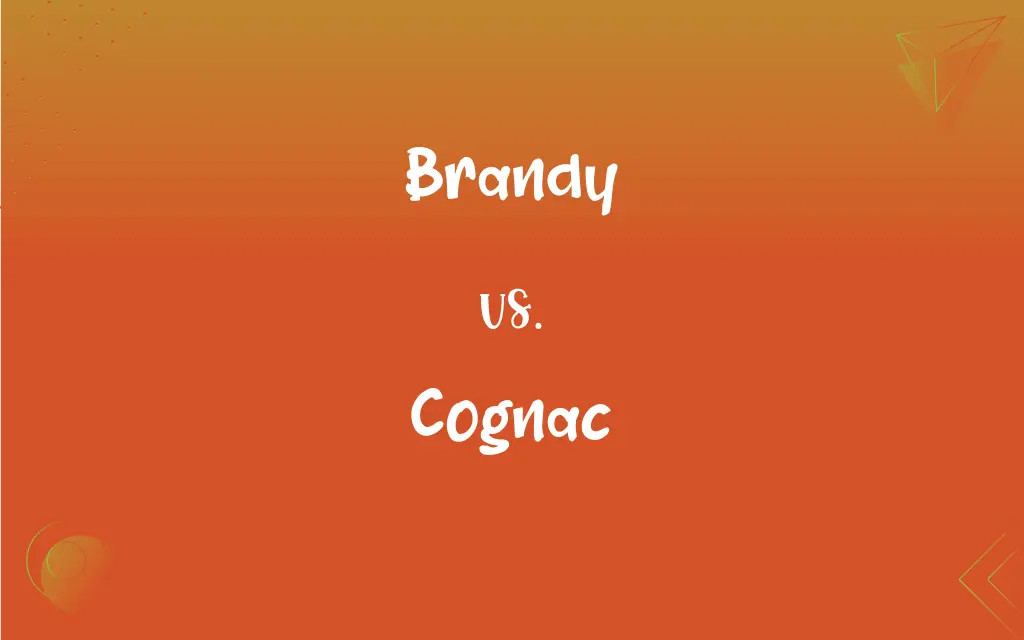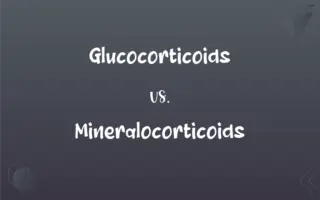Brandy vs. Cognac: What's the Difference?
Edited by Janet White || By Harlon Moss || Updated on October 18, 2023
Brandy is a spirit distilled from fermented fruit juice; cognac is a high-quality brandy specifically from the Cognac region of France.

Key Differences
Brandy, as a broad term, refers to a distilled spirit made from fermented fruit juice, most commonly grapes. Cognac, on the other hand, is a specific type of brandy that originates from the Cognac region in France.
While all cognac is brandy, not all brandy can be classified as cognac. The distinction between brandy and cognac is largely based on origin, but there are also strict production methods associated with cognac.
Brandy can be produced anywhere in the world and might vary in quality and flavor profiles. Cognac undergoes a rigorous production process, governed by French law, ensuring that it maintains its high-quality reputation. This includes specific grape varieties, double distillation in copper pot stills, and aging in Limousin or Tronçais oak barrels for at least two years.
Therefore, brandy offers a diverse range of flavors and qualities, cognac is recognized for its consistent quality and unique flavor profile influenced by its specific region.
Comparison Chart
Basic Definition
A distilled spirit made from fermented fruit juice.
A type of brandy from the Cognac region of France.
ADVERTISEMENT
Region of Production
Can be produced worldwide.
Must be produced in the Cognac region of France.
Production Requirements
Varies based on region and producer.
Strictly governed by French law.
Aging
Varies, with no minimum requirement in many places.
Must be aged in specific oak barrels for at least two years.
Grape Varieties
Can be made from various fruit juices.
Made primarily from specific grape varieties like Ugni Blanc.
Brandy and Cognac Definitions
Brandy
Brandy can be enjoyed neat or in cocktails.
He ordered a brandy-based cocktail at the bar.
ADVERTISEMENT
Cognac
Cognac comes exclusively from the Cognac region.
Authentic cognac is a testament to its French heritage.
Brandy
Brandy is made from fermented fruit juice.
Grape is the most common fruit used to produce brandy.
Cognac
Cognac is known for its rich and complex flavors.
She could identify the subtle notes of vanilla and oak in the cognac.
Brandy
Brandy is a distilled alcoholic beverage.
She poured a small glass of brandy to warm up.
Cognac
Cognac is a premium brandy from France.
He decided to splurge on a bottle of fine cognac for his anniversary.
Brandy
Brandy's flavor profile varies depending on its origin.
Spanish brandy has a different taste compared to its American counterpart.
Cognac
Cognac undergoes a rigorous production process.
The distillation method adds to the unique flavor of cognac.
Brandy
Brandy's color deepens with aging.
The deep amber hue of the brandy indicated its extended aging.
Cognac
Cognac's quality classifications include VS, VSOP, and XO.
He preferred XO cognac for its refined and mature taste.
Brandy
An alcoholic liquor distilled from wine or fermented fruit juice.
Cognac
A brandy distilled from white wine and produced in the vicinity of Cognac.
Brandy
To preserve, flavor, or mix with brandy.
Cognac
A brandy distilled from white wine in the region around Cognac in France.
Major manufacturers add a small proportion of caramel to color their cognacs.
Cognac
A kind of French brandy, so called from the town of Cognac.
Cognac
High quality grape brandy distilled in the Cognac district of France
FAQs
Can brandy be made from fruits other than grapes?
Yes, brandy can be made from various fermented fruit juices, like apples or pears.
Can a brandy made outside of France be labeled as cognac?
No, only brandy from the Cognac region of France can be labeled as cognac.
What is the significance of labels like VS, VSOP, and XO on cognac bottles?
These labels indicate the age and quality of the cognac, with XO being the highest quality among the three.
Is cognac a type of brandy?
Yes, cognac is a specific type of brandy from the Cognac region of France.
What makes cognac distinct from other brandies?
Cognac must come from the Cognac region in France and adhere to strict production and aging standards.
Why is cognac often associated with luxury?
Due to its strict production standards, historical significance, and often intricate packaging, cognac has garnered a reputation for luxury.
Are there other regions in France that produce brandy?
Yes, other regions like Armagnac also produce brandy, but they have distinct characteristics from cognac.
Why is the region so important in defining cognac?
The Cognac region has specific climate, soil, and traditions that impart unique characteristics to the spirit.
Are there health benefits to consuming brandy or cognac?
While moderate consumption might offer some benefits, excessive drinking can be harmful. Always consume alcohol responsibly.
Can one find brandies that rival the quality of a good cognac?
Yes, there are high-quality brandies worldwide that can match the taste and refinement of a good cognac.
What does "double distilled" mean in the context of cognac?
It refers to the process where the fermented juice is distilled twice in copper pot stills to achieve purity and concentration.
What foods pair well with cognac?
Cognac pairs well with chocolates, cheeses, dried fruits, and many desserts.
Can brandy be used in cooking?
Yes, brandy is often used in sauces, desserts, and flambé dishes.
How should one best enjoy cognac?
Cognac is best enjoyed neat, at room temperature, in a tulip-shaped glass.
What's the main ingredient of cognac?
Cognac is primarily made from Ugni Blanc grapes.
What's the difference between brandy and whiskey?
Brandy is made from fermented fruit juice, while whiskey is distilled from fermented grain mash.
How does aging impact the flavor of brandy and cognac?
Aging imparts depth and complexity to both brandy and cognac, adding flavors from the oak barrels.
What is the alcohol content in brandy and cognac?
Typically, both brandy and cognac have an alcohol content ranging from 35% to 60%.
Is cognac typically more expensive than other brandies?
Generally, cognac tends to be more expensive due to its strict production standards and prestigious reputation.
Can you make cocktails with cognac?
Yes, cognac is a versatile spirit and can be used in a variety of cocktails.
About Author
Written by
Harlon MossHarlon is a seasoned quality moderator and accomplished content writer for Difference Wiki. An alumnus of the prestigious University of California, he earned his degree in Computer Science. Leveraging his academic background, Harlon brings a meticulous and informed perspective to his work, ensuring content accuracy and excellence.
Edited by
Janet WhiteJanet White has been an esteemed writer and blogger for Difference Wiki. Holding a Master's degree in Science and Medical Journalism from the prestigious Boston University, she has consistently demonstrated her expertise and passion for her field. When she's not immersed in her work, Janet relishes her time exercising, delving into a good book, and cherishing moments with friends and family.































































